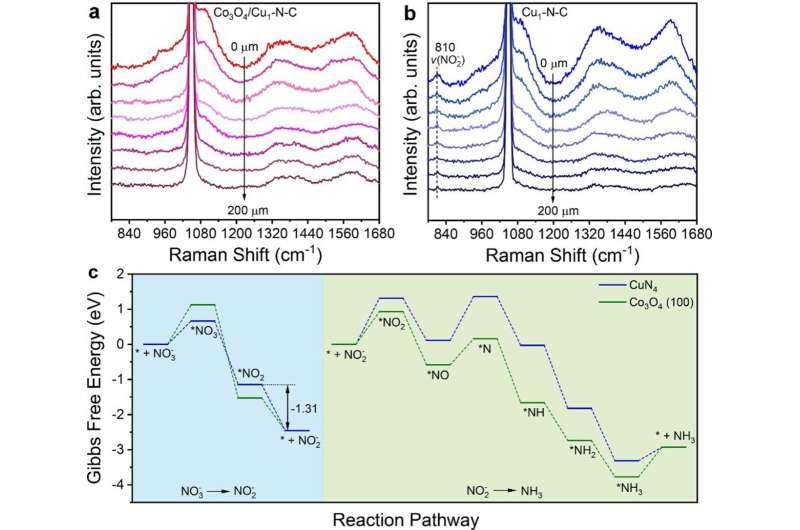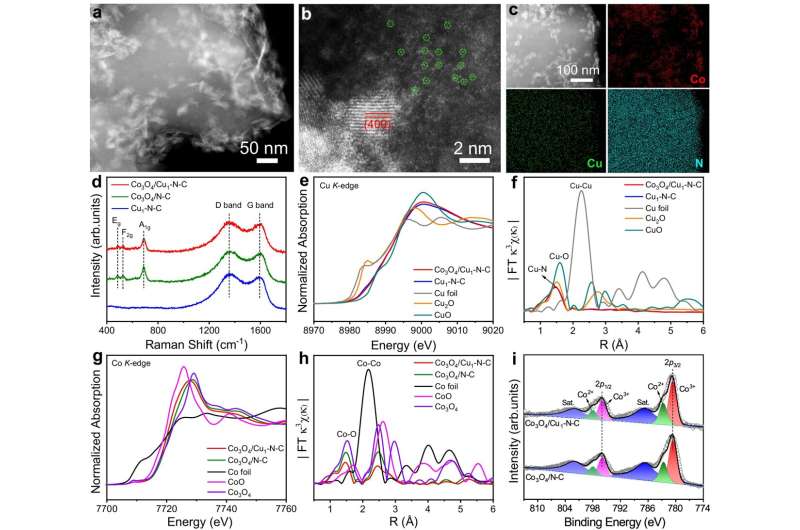This article has been reviewed according to Science X's editorial process and policies. Editors have highlighted the following attributes while ensuring the content's credibility:
fact-checked
peer-reviewed publication
proofread
Researchers develop efficient tandem catalyst to enhance nitrate electroreduction to ammonia

A research team has designed a tandem catalyst to improve the electroreduction of nitrate into ammonia. By coupling Cu single atom catalysts with adjacent Co3O4 nanosheets, the team successfully regulated the adsorption energy of intermediates in the nitrate electroreduction process, promoting the synthesis of ammonia.
Their findings are published in Nature Communications. The team was led by Prof. Zeng Jie and Prof. Geng Zhigang from the University of Science and Technology of China (USTC) of the Chinese Academy of Sciences (CAS).
Converting nitrate (NO3-) from wastewater into ammonia (NH3) not only offers an effective approach to wastewater treatment but also holds promise as a sustainable method for ammonia synthesis. However, the diverse adsorption configurations of nitrogen-containing intermediates in the NO3- electroreduction process pose a challenge, making it difficult for a single catalyst to optimize adsorption simultaneously.
While Cu-based electrocatalysts are advantageous for NO3- adsorption, one key issue is the excessive accumulation of nitrite (NO2-) which would result in the rapid deactivation of catalysts and sluggish kinetics of subsequent hydrogenation steps.
To overcome these limitations, the researchers designed a tandem electrocatalyst by combining Cu single atoms anchored on N-doped carbon with adjacent Co3O4 nanosheets (denoted as Co3O4/Cu1-N-C). This innovative combination leverages the strengths of both components: Cu's ability to adsorb NO3- and Co3O4's ability to adsorb NO2-. This dual-function catalyst aims to optimize the binding energies of intermediates, thereby facilitating the electroreduction process from NO3- to NH3 more efficiently.

Specifically, the researchers synthesized the Co3O4/Cu1-N-C catalyst through a series of steps, including the pyrolysis of Cu-doped ZIF-8 to obtain Cu single atoms on N-doped carbon, followed by the deposition of Co3O4 nanosheets. The structure and composition of the catalyst were characterized using various techniques such as high-angle annular dark field scanning transmission electron microscopy (HAADF-STEM), energy-dispersive X-ray spectroscopy (EDS), and X-ray absorption near edge structure (XANES) spectroscopy.
These analyses confirmed the successful combination of Cu single atoms and Co3O4 nanosheets, as well as the uniform distribution of the catalytic centers.
Finally, performance testing of the catalysts was conducted in a three-electrode H-type cell, with the concentration of NH3 product quantified using the indophenol blue method. The test revealed that Co3O4/Cu1-N-C achieved an ammonia production rate of 114.0 mgNH3h-1cm-2 in the NO3- electroreduction reaction, which was 2.2 times and 3.6 times as high as that of Cu1-N-C and Co3O4, respectively.
Mechanistic investigations showed that Co3O4 effectively regulates the adsorption configuration of NO2- and enhances its binding, thereby accelerating the overall electroreduction process from NO3- to NH3.
This research highlights a novel approach to addressing the limitations of single catalysts in nitrate electroreduction by using a tandem catalyst system. It not only provides a deeper understanding of the catalytic mechanisms involved but also sets the stage for future developments in the design of advanced electrocatalysts for similar applications.
More information: Yan Liu et al, Efficient tandem electroreduction of nitrate into ammonia through coupling Cu single atoms with adjacent Co3O4, Nature Communications (2024). DOI: 10.1038/s41467-024-48035-4
Journal information: Nature Communications
Provided by University of Science and Technology of China




















